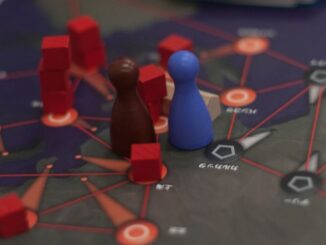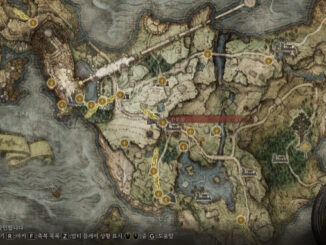
Last week I wrote an article in praise of the versatility of cards. It feels only right in the name of symmetry to complement it with a companion piece giving the same level of scrutiny to that other workhorse of analogue games – the die.
My husband wrote a comment on LinkedIn a couple of weeks ago mentioning that I carry round a selection of dice with me at all times ‘just in case’. This is perfectly true, and over the years the selection of dice types in my little pouch has moved well beyond cubes with 21 dots, to include different symbols and different shapes. So far, I’ve been prepared for every ‘just in case’, but like cards, dice are just so versatile, and new mechanics are being created/discovered all the time, so it’s only a matter of time….
Beyond pips and cubes
The flatness of cards informs how they can be played with, and in the same way, the fact that dice are 3D objects opens up different possibilities for their use. Although I do own some spherical (internally weighted) dice, these are by way of being novelties, and most dice require a shape which will allow them to reliably land, and stay, on one face, so that another face can be upwards and display a ‘result’. With one (at least in the commonly used dice) notable exception, the tetrahedral die, this means that they can be stacked.

They are compact, and can therefore be used as counters, markers or game pieces in other capacities, in relatively high numbers, without taking up too much space.
Varying the number of faces has the obvious effect of changing the number of different outcomes or values that a die can ‘hold’. Add to that the potential to substitute with any kind of value or symbol that will fit on a face, and you have nearly endless options for using dice in play.
Randomness and Chance
Dice are most well known as components to produce random results, and even when they are used in the many different ways listed below, randomness still often features in the way they are used.
For the purposes of this article, the simple action of producing random results is not an especially interesting mechanic for dice, simply because it is so widely-used and well-known, so I will not examine it in detail, but mention randomness and chance where relevant in the explorations below
Pieces with magnitude
As 3D objects, dice can be used in a game as counters or tokens, fulfilling the jobs that these pieces usually do, such as recording progress or marking positions on a board. However, possessing numbered faces means that these pieces also have magnitude.

One game where this is used really well is Dice Hospital. Dice are used to represent patients, and the face value of any particular die shows the current level of ‘sickness’ of the patient. Patients are treated, and their increasing health is indicated by turning the die to a higher value, until they are discharged, earning points for the player. Untreated patients get sicker, and if that means they are turned to a value of 1 or below, they die.
Dice Hospital is available from Amazon
In another way this could be seen as the value of the die being augmented or being ‘used up’, and this opens up possibilities for the values on dice being available as spendable ‘currency’ in a game. In its simplest form this is what happens in roll and move games like backgammon, where you ‘pay for’ moves with your dice pips.
Other ways in which these ideas could be deployed:
- Pips on a collection of randomly rolled dice determine how may actions points are available to a player.
- A piece moves along a track trying to reach the end before all pips are ‘spent’
- Different pip values correspond to different actions that can be taken
- Pip values of more than one die can be added to make ‘stronger’ dice
Dice as resources
Resources can also be represented numerically, but different symbols (or indeed colours) are often used where dice are used to represent material resources in a game. In Castle Dice (now sadly out of print), colour, symbols and numbers are used to signify resources which are rolled into a shared ‘World’ at the beginning of each round, and then drafted into each player’s individual holding in turn, enabling them to pay to build parts of a castle.
Other possibilities include:
- Worker placement using dice – Alien Frontiers also allows for special placement depending on the throwing of doubles or trebles
- Direct use of dice as a game resource, as in worker placement, or use of the die as currency – with or without reference to the value shown on a die face
- Direct use of die utilising its physical characteristics, e.g. stacking to build a tower or wall
Alien Frontiers is available on Amazon
Ranking and allocation
Numeric dice facilitate ranking, for a number of ranks equal to or less than their faces, and dice with either numbers of symbols can be allocated to corresponding categories of things within a game.
In the game Corinth, for example, players roll a pool of (six-sided) dice at the start of their turn. The dice are sorted into groups of face value, and placed on a six category board. All dice that show the highest value are placed in the topmost category, and all dice showing the lowest value are placed in the lowest category. Then the remaining groups of dice are allocated to the remaining categories starting from the next bottom category.
Corinth is available on Amazon
This is an ingenious way of making some categories rarer than others. If dice were simply allocated in categories 1 to 6, over time, the probability of rolling each category would even out. With this method, the ‘higher’ categories, other than the topmost, become ‘rarer’ because some rolls will include gaps where no dice show a particular value, and these gaps will then be allocated to the higher categories.
Colour and other characteristics
Colour can be used to identify dice as ‘belonging’ to a specific player – as in the worker (bee) placement game Waggle Dance, or can add an additional aspect to the dice, for example, different rules or powers could apply to different coloured dice. In Sagrada, the game of stained glass windows, each board has restrictions about which colour of dice can be placed, and further rules about allowable ‘shades’ (designated by the die value).

Sagrada is available on Amazon
In this way, characteristics of the die can be ‘layered’ one over another to ‘encode’ complex information in the object itself. These characteristics include:
- Die shape (e.g. cube, dodecahedron etc.)
- Numeric face values
- Die size
- Colour
- Symbols on faces
Additionally, more information can be encoded by the interaction of dice with the other components of the game:
- Position on a board
- Position relative to other dice / components (including stacking, tessellation and other arrangements allowed by the shape of the dice)
- Timing of ‘playing’ the die
- Combination of a die with another component when ‘playing’
Through combination of these characteristics, the possibilities for what a die can do or be within a game is effectively limitless. For example, let’s say that in a particular (worker placement) game, COLOUR represents a category of worker (project manager, consultant, intern), and SHAPE represents level of experience (a greater number of faces representing more years), SIZE could represent rank/salary band within the company, and the SYMBOLS represent specific skills to be utilised in a game action.
Dice can be played to a BOARD POSITION to represent deployment to a project, and could be COMBINED with other dice to create customised actions composed of multiple skills. TESSELLATION of dice within a project space could represent weighting of worker influence on project outcomes.
All this would probably (almost certainly) create unnecessarily complex mechanics in a game, but it does demonstrate the complexity of game information that can be held in a very small component.
Other possibilities
This article has been a relatively brief exploration of the potential for dice in game design. Other possibilities will be discussed in a further article, in the interests of keeping each one of a manageably readable size. These will include, dice as mechanism for scoring, mutable dice, deckbuilding with dice, and using dice as playable surfaces, among others.
In the meantime, I hope you enjoy experimenting with the ideas above in your own game design.
- James Bore – The Ransomeware Game - 13th February 2024
- Ipsodeckso – Risky Business - 23rd January 2024
- Review – Luma World Games - 15th December 2023





Be the first to comment